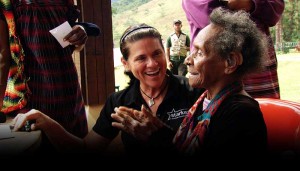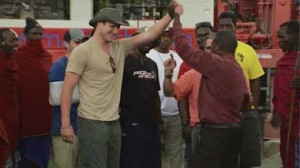
Emmys, like their Oscar counterparts, are about honoring a primarily visual medium. Film was silent before audio got involved, and with the arrival of HD and 3-D, audiences are demanding more visual spectacle than ever before.
Still though, the spectacle isn’t complete without words, music and sound – and it’s that latter aspect, the “hearing” – that motivates the documentary series Operation Change, broadcast on Oprah Winfrey’s OWN.
The series springs from a mission by the Starkey Hearing Foundation (which itself grew from the Starkey Hearing Technologies company) to bring the gift of hearing, through dispersing hearing aid technology, to impoverished communities throughout the world.
From there, the mission grew in scope to not only aid such communities, but to help those in them – and in particular those outside them – “hear better.”
 Thus, the 10-part Operation Change finds itself in far-flung corners of the globe, from the strife-ridden West Bank to the lesser known villages of Papua New Guinea. And the series has enlisted considerable support, from President (and potential future First Man) Bill Clinton, and his Clinton Foundation, to Sir Elton John (also enlisting his own AIDS foundation), Sir Richard Branson, the Dalai Lama and more.
Thus, the 10-part Operation Change finds itself in far-flung corners of the globe, from the strife-ridden West Bank to the lesser known villages of Papua New Guinea. And the series has enlisted considerable support, from President (and potential future First Man) Bill Clinton, and his Clinton Foundation, to Sir Elton John (also enlisting his own AIDS foundation), Sir Richard Branson, the Dalai Lama and more.
The marquee players certainly bring more attention to the various causes – whether it’s building schools in Tanzania and housing for teachers, or skate parks in Lebanon, or symbolic bridges in Palestine. The series has generally found itself plunging into areas not often seen by many First World film crews.
Which brings up interesting below-the-line aspects for Operation Change. In a recent episode screened for Emmy consideration, the producers showed the 10th of 10 episodes, where they went to Papua New Guinea. But Hollywood A-listers weren’t there for this segment – only the main personnel from Operation Change – Starkey Hearing CEO Bill Austin, his wife Tani and their son, producer Steven Sawalich, along with Operation Change volunteers.
Their goal is to work with local community leaders, not to impose change from outside, but to help nurture it, organically, in situ.
 In the case of the New Guinea episode, they traveled into the interior to a village that had been engaged in a years-long skirmish with the neighboring village, resulting in untimely deaths, scarred psyches, grieving orphans grown to manhood without fathers, and a depletion of both the nearby forest and croplands, along with any incipient infrastructure like latrines that may have once existed.
In the case of the New Guinea episode, they traveled into the interior to a village that had been engaged in a years-long skirmish with the neighboring village, resulting in untimely deaths, scarred psyches, grieving orphans grown to manhood without fathers, and a depletion of both the nearby forest and croplands, along with any incipient infrastructure like latrines that may have once existed.
In the episode then we see a small coterie of Operation Change staff and volunteers, coordinating with, and working alongside, locals in New Guinea, both in the village, and with NGOs there working to change conditions for their countrymen.
Not that conditions are always easy to change. When Operation Change wanted to build a soccer field where both Palestinian and Israeli kids could play, they received, inevitably, bomb threats before the field could be used. But they decided it was important to go ahead and finish the work.
Throughout all the downs and ups (the New Guinea episode has a touching moment where an elderly woman dances with joy when her hearing is restored), there is quite a well-developed crew on the other side of the camera, managing, it would seem, to leave a light footprint.
 According to Sawalich, there are some 35-45 crewmembers on a shoot (though in the New Guinea episode they were split between villages), using upwards of five different cameras, from Red Epics to Sony iterations like the F800 and the F3.
According to Sawalich, there are some 35-45 crewmembers on a shoot (though in the New Guinea episode they were split between villages), using upwards of five different cameras, from Red Epics to Sony iterations like the F800 and the F3.
“The F800 is a great workhorse,” he told us, and they particularly like it for the shallow depth of field it provides.
“Post was a challenge,” he said, with sound being another issue. Mainly because with the verite style of filming, there is always a lot of ambient noise that has to be cleaned up. Though care was often taken not to make it too clean, in order to give the viewer a sense of not only the sights, but the sounds, of these strife-torn areas.
And sound, after all, is where the whole project started. Austin talked about hoping his series could bring a “butterfly effect” of change to the world. Small, tangible changes, making a difference in the day-to-day lives of the communities who administer those changes.
The question is whether you can hear those butterfly wings flapping, or not, if you listen carefully enough.





